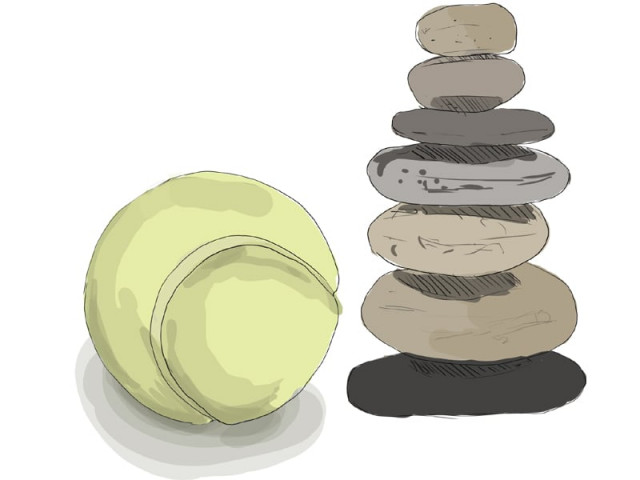Trip down memory lane: The games we play...
Kho kho, pittu garam and gilli danda… where did they come from and what do they mean to us?

The organically evolved games we learn from our parents, friends and schoolteachers are the ones that resonate most profoundly. The simpler and more universal they are, the better. Variations on games like tag, catch-me-if-you-can and hide-and-seek are so ubiquitous that they have become a universal reference point of fun and happiness for children and adults the world over.
Then there are those amusements that depend only on a child’s imagination. I remember how, during weddings in my childhood, my friends and I would pretend that the festivities were about to be disrupted by a band of pirates. At once, a tediously formal function would become a wondrous adventure. We would ransack the kitchens, conduct covert operations beneath the dining tables and send each other coded messages about the latest twists and turns in the never-ending saga. The whole charade was pure and unadulterated joy.
In Pakistan, Mughal, British, Sikh, Hindu, Persian and Muslim influences have combined over the centuries to create a vibrant cultural heritage of games and pastimes. Kabbadi, for example, is a game that has been played on the subcontinent since ancient Vedic times. It is mentioned in the great Hindu epic, the Mahabharata, and in Buddhist literature Buddha himself is referred to as playing kabaddi for recreation. Similarly, the run-chase game kho kho, which involves touching and chasing opponents, also has its origins in Vedic culture.
Originally developed in the western state of Maharashtra, it used to be played on chariots and was known as Rathera. Nowadays, the chariots may have been dispensed with, but it remains as highly charged and tactical as ever. In my childhood, kho kho was a firm favourite with girls in the playground, and their urgent cries of “Kho” every time a player was tagged, would be followed by squeals of glee.
A number of board games have also originated from the subcontinent. Although rooted in ancient India, these games really blossomed under the patronage of the Mughal emperors. The ancient Hindu game of pachisi — the forerunner for today’s perennial party time favourite, Ludo — was often played by the Emperor Akbar. Though nowadays Ludo is likely to be played by children on a magnetic board, it is reported that Akbar used to play the game on the colossal outdoor chessboard in Agra Fort with young slave girls used in place of the traditional coloured ivory pieces. The ancient game of chess or Shatranj, was also hugely popular in the Mughal courts.
My own introduction to the games of the subcontinent occurred in 1990 when, as an eight-year-old, I visited Pakistan with my parents. I was badgered into playing pittu garam at a cousin’s ameen. The whole experience was a spectacular revelation. I was enthralled by the ritual of scavenging for the flattest stones in order to create the pittu, the buzz of anticipation each time the ball was thrown at the crudely assembled target and the clamour that would ensue as stones whizzed in all directions and pandemonium reigned supreme. It was exhilarating, but what struck me was that the importance of pittu garam lay not in victory and defeat, but in the accuracy of the aim and the speed. The contemptible matter of keeping score was merely secondary.
When I returned to the land of my parents as an adult, it was refreshing to see that, in an age of Playstations and Wiis, traditional games were as popular as ever. Yassu, panju, haar, kabootar, doli , for example, is a favourite of children all over the country. The appeal of the game, like so many other classics, lies in its inventiveness and simplicity. Before each round, up to five players are randomly assigned one of the five names that make up the title of the game. They then draw a random amount of fingers, and the names are counted on each one. The player whose name comes up is considered safe and withdrawn from the contest. The last remaining contestant is considered the loser. And then there comes the twist. From being a mundane playground rhyming activity, yassu, panju becomes a thrilling contest of wit and speed which can be enjoyed by children of all ages. The winning player is assigned the task of slapping the hands of the loser. Each time the winner successfully hits the losing player he or she gets another go. Like pittu garam, the emphasis is not on amassing points but in displaying one’s skill and talent.
Gilli-danda, derived from the Italian game Lippa, provides the defining image of a Pakistani childhood. There is a dust track near where I live, where children still gather after the Asr prayer to play gilli. The moment that the danda successfully strikes the gilli, it takes to the air like a frightened bird as though carried up by the cloud of dust that rises with it. In late summer evenings, the spectacle is made all the more enchanting by the excited screams and shouts of the players. It is comforting to note, that unlike in the West, there are still patches of ground throughout Pakistan which the authorities have to yet to reclaim from playing children.
If there are two things children love, they are rhymes and hitting others . . . which might explain why the quintessentially desi kokla chapaki is such a popular pastime in rural Punjab. The nonsense rhyme, “kokla chapaki jumeraat aayi aye jera agge pichey wekhey ohdi shamat aayi aye” sung by the participants who sit in the circle is fun and joyful. It is at once very much rooted in its locality yet appears to be a song for children of all nations. More potent than the rhyme is the dupatta, the principal tool of the game, which at once symbolises culture and is used to whip the player who fails to notice that it has been put behind his back.
On a recent trip to Gilgit, I discovered that children there have invented their own variation on the region’s most popular sport polo. Pulu, as the locals called it, follows most of the traditional rules of the equestrian game, except that it is played without horses. Pulu sticks are made from branches of birch trees which are abundant in the region and the ball either consists of a roll of socks or a bundle of string. The game can perhaps best be described as a cross between polo and hockey.
A young boy in the mountain village of Guppa near Naltar described how pulu was the chief pastime of children in the summer. “During the summer, most families leave the cities and gather in their villages. Playing pulu with my cousins and the other children of the village is the highlight of our holidays.” The playful sounds of children running around on the flattest tract of land they could find, with the Karakoram towering in the background, evoked a delightful image of celebration and joy.
In childhood, being a grown-up seems to be filled with an alluring mystique and wonder, yet when we attain adulthood, we look back, misty-eyed at the serendipity of youth. We may no longer run around, jump and clamour when we are feeling down, sing silly songs to relieve our pressures, or pretend to be warriors or astronauts when we want an escape from our own lives – but we do possess a treasure trove of games to pass onto our children to make their childhoods as joyous as our own.
Published in The Express Tribune, Sunday Magazine, August 14th, 2011.



















COMMENTS
Comments are moderated and generally will be posted if they are on-topic and not abusive.
For more information, please see our Comments FAQ